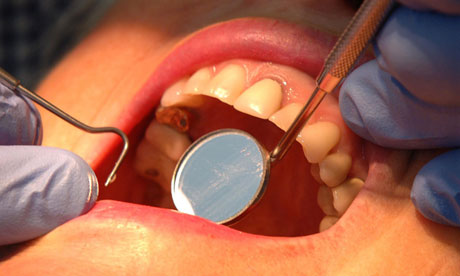
据英国媒体3月9日报道,英国伦敦国王学院的研究人员提取成人牙龈组织细胞,将其与取自老鼠的另一种细胞结合,成功培育出一颗新牙。他们表示,将来某一天,牙医有可能为缺牙患者换上这种新牙齿。
在最新的研究中,他们从成人患者的牙龈中提取上皮细胞,在实验室里大量培养,再将它们与老鼠的间质细胞混合。这种间质细胞被培养出“诱导作用”――“指示”上皮细胞开始发育成为牙齿。研究人员把这种细胞混合物移植到老鼠身上,结果长出拥有成活根部的人鼠混合牙。
研究人员表示,下一步将是找到可轻易获取的人类间质细胞资源,并培养出足够的细胞,使之成为能够应用于临床的有效技术。
据研究团队负责人保罗・夏普教授透露,他们可以在智齿的牙髓中找到所需的间质细胞,但是可获得的量很有限。现在要做的是寻找获取间质细胞的简单方法。“而下一个主要挑战是研究将成人间质细胞培养成为牙齿诱导物的方法,现在,我们只能利用胚胎间质细胞做到这一点。”
他还称,希望这种技术将来可以取代目前使用的无法复制自然牙根结构的种植牙。不过,要达到这个目的,它的价格必须类似于种植牙,因此要找到简单而廉价的方法。
卡迪夫大学骨生物学与组织工程学专家阿拉斯泰尔・斯隆教授表示,这项工作意义重大,也是令人兴奋的进步;目前这类研究对临床的最大影响是牙齿生物填料的研发,在未来10至15年内,该技术有望得到部分应用。
据中国日报
英国卫报原文:

People may in future be able to have missing or diseased teeth replaced with ones grown from cells taken from their own mouth, scientists have predicted.
Hybrid teeth created by combining human gum cells and stem cells from mouse teeth have been grown in laboratory mice by researchers who hope the work could lead to dentures being superseded by new teeth grown on a patient's jaw.
The mixture of mouse and human cells was transplanted into adult mouse kidneys and grew into recognisable tooth structures coated in enamel with viable developing roots, according to a study published in the Journal Of Dental Research.
Two kinds of cell were used to make the bioengineered teeth. Epithelial "surface lining" cells were taken from human gum tissue and mesenchymal stem cells from the mouse embryos.
Mesenchymal cells can develop into a range of different tissues, including bone, cartilage and fat.
Professor Paul Sharpe, who led the research at King's College London's dental institute, said: "Epithelial cells derived from adult human gum tissue are capable of responding to tooth-inducing signals from embryonic tooth mesenchyme in an appropriate way to contribute to tooth crown and root formation and give rise to relevant differentiated cell types, following in-vitro culture.
"These easily accessible epithelial cells are thus a realistic source for consideration in human biotooth formation. The next major challenge is to identify a way to culture adult human mesenchymal cells to be tooth-inducing, as at the moment we can only make embryonic mesenchymal cells do this."
Previous research has shown that embryonic teeth are capable of developing normally in the adult mouth.
"What is required is the identification of adult sources of human epithelial and mesenchymal cells that can be obtained in sufficient numbers to make biotooth formation a viable alternative to dental implants," said Sharpe.
原文链接 http://www.guardian.co.uk/science/2013/mar/09/tooth-replacement-mouse-cells



